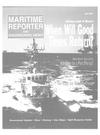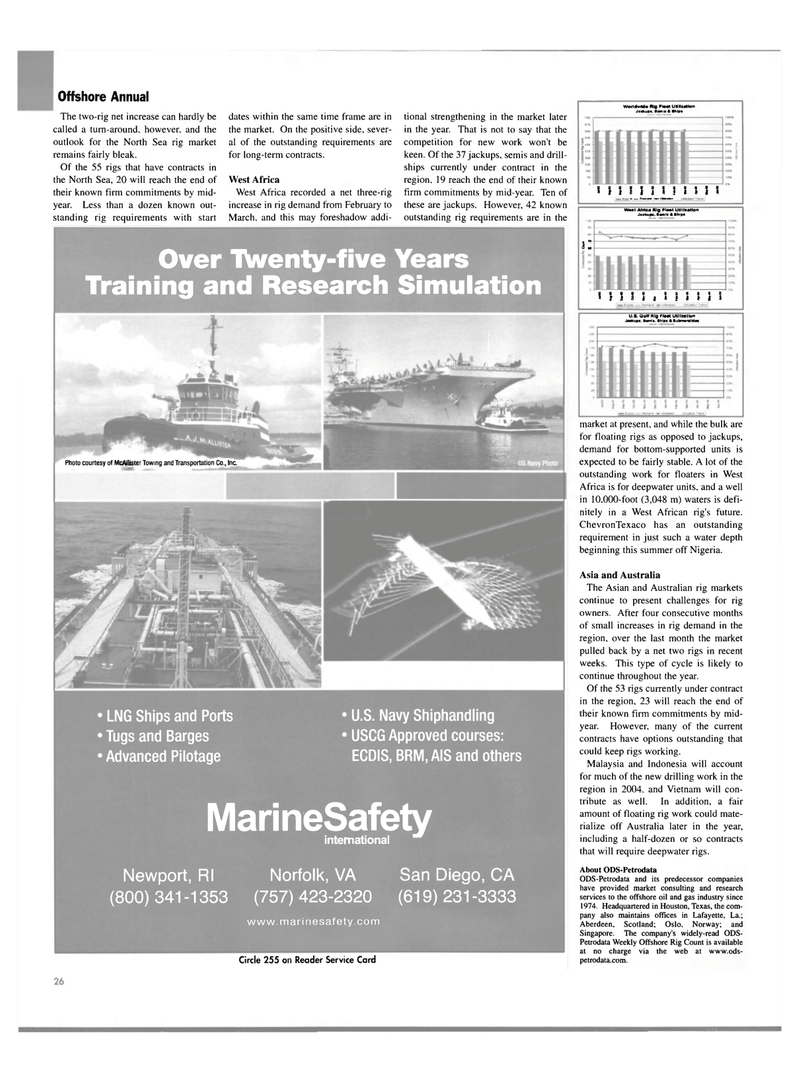
Page 26: of Maritime Reporter Magazine (April 2004)
Offshore Technology Yearbook
Read this page in Pdf, Flash or Html5 edition of April 2004 Maritime Reporter Magazine
Offshore Annual
The two-rig net increase can hardly be called a turn-around, however, and the outlook for the North Sea rig market remains fairly bleak.
Of the 55 rigs that have contracts in the North Sea, 20 will reach the end of their known firm commitments by mid- year. Less than a dozen known out- standing rig requirements with start dates within the same time frame are in the market. On the positive side, sever- al of the outstanding requirements are for long-term contracts.
West Africa
West Africa recorded a net three-rig increase in rig demand from February to
March, and this may foreshadow addi- tional strengthening in the market later in the year. That is not to say that the competition for new work won't be keen. Of the 37 jackups, semis and drill- ships currently under contract in the region, 19 reach the end of their known firm commitments by mid-year. Ten of these are jackups. However, 42 known outstanding rig requirements are in the
Worldwide Rig Ftp* Utilization
Jiohupa. ••mil 4 Ship* n n i s i i n i i
V mm On* ma ^IMMWB-
Weit Africa Rig Fleet Utilization
Jackup*. Semla ft Shlpa i:
U ! 3 1 i s IS i H
U.i (Wri6 >W Utlllatlon
JMKUP*. Pwnia Shlpa 4 «ubmp>*lblM market at present, and while the bulk are for floating rigs as opposed to jackups, demand for bottom-supported units is expected to be fairly stable. A lot of the outstanding work for floaters in West
Africa is for deepwater units, and a well in 10,000-foot (3,048 m) waters is defi- nitely in a West African rig's future.
ChevronTexaco has an outstanding requirement in just such a water depth beginning this summer off Nigeria.
Asia and Australia
The Asian and Australian rig markets continue to present challenges for rig owners. After four consecutive months of small increases in rig demand in the region, over the last month the market pulled back by a net two rigs in recent weeks. This type of cycle is likely to continue throughout the year.
Of the 53 rigs currently under contract in the region, 23 will reach the end of their known firm commitments by mid- year. However, many of the current contracts have options outstanding that could keep rigs working.
Malaysia and Indonesia will account for much of the new drilling work in the region in 2004. and Vietnam will con- tribute as well. In addition, a fair amount of floating rig work could mate- rialize off Australia later in the year, including a half-dozen or so contracts that will require deepwater rigs.
About ODS-Petrodata
ODS-Petrodata and its predecessor companies have provided market consulting and research services to the offshore oil and gas industry since 1974. Headquartered in Houston, Texas, the com- pany also maintains offices in Lafayette, La.;
Aberdeen, Scotland; Oslo, Norway; and
Singapore. The company's widely-read ODS-
Petrodata Weekly Offshore Rig Count is available at no charge via the web at www.ods- petrodata.com.
Over Twenty-five Years
Training and Research Simulation
U.S. Navy Shiphandling
USCG Approved courses:
ECDIS, BRM, AIS and others
LNG Ships and Ports
Tugs and Barges
Advanced Pilotage
MarineSafety international
Newport, Rl Norfolk, VA San Diego, CA (800) 341 -1353 (757) 423-2320 (619) 231 -3333 www.marinesafety.com
Photo courtesy of McAllister Towing and Transportation^CaJnc.
Circle 255 on Reader Service Card

 25
25

 27
27
